9 Best Native Plants for Western Pennsylvania
BY RELA CATUCOD | MAY 20TH, 2023 | LAWN CARE, WESTERN PENNSYLVANIAWestern Pennsylvania, celebrated for its picturesque Allegheny Mountains and the Laurel Highlands’ lush valleys, is home to a rich variety of native plants. The region’s distinct landscapes provide an ideal setting for sustainable gardens, which is why we’ve created a list of the best native plants for Western Pennsylvania.
There are several beneficial reasons to grow native plants. Native plants:
- Support local wildlife like pollinators, caterpillars, and birds
- Require less maintenance and water than non-native plants
- Resist local pests and diseases more effectively
- Promote a healthier ecosystem by preserving the natural balance
Growing native plants of Western Pennsylvania helps you make a colorful, well-balanced environment in your own yard. If you’re excited to learn about native plants, we have some great options for your Western Pennsylvania garden.
In this article, we’ll talk about:
- 9 Native Plants for Your Western Pennsylvania Garden
- How to Choose Native Plants for Your Western Pennsylvania Landscape
- FAQ About Western Pennsylvania Native Plants
- Where to Find Native Plants in Western Pennsylvania
9 Best Native Plants for Your Western Pennsylvania Garden
1. Black-Eyed Susan (Rudbeckia hirta)
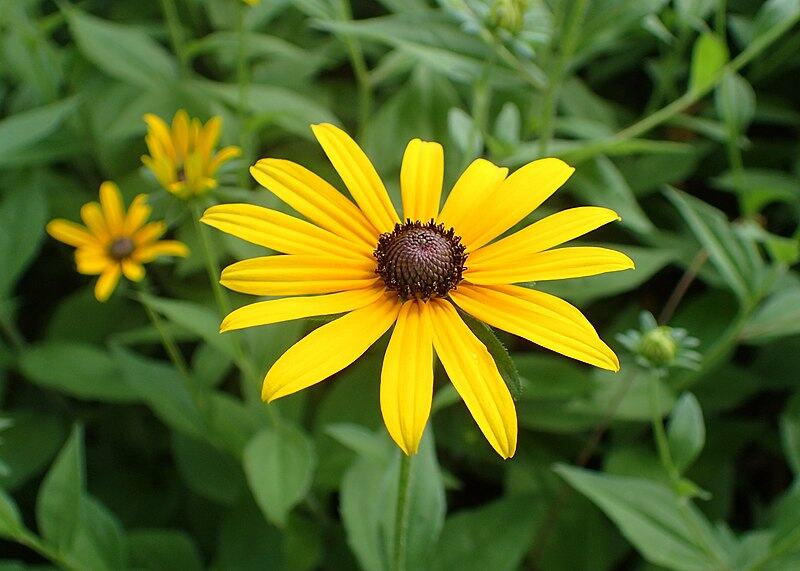
Photo Credit: Krzysztof Ziarnek, Kenraiz / Wikimedia Commons / CC BY-SA 4.0
Black-eyed Susan is a popular native wildflower with bright yellow flowers and a dark brown central cone. This eye-catching plant graces gardens from spring until early fall, providing a long-lasting burst of color. Not only does it add aesthetic appeal, but the black-eyed Susan also plays a crucial role in attracting butterflies and various pollinators, contributing to a thriving ecosystem.
Plant type: Flower
USDA Hardiness Zone: 3 to 9
Sun: Full sun
Soil: Clay, sand, loam, acidic, moist, well-drained soil
Duration: Depending on growing conditions, it can act as a biennial, annual, or short-lived perennial
Fragrance: Sweet
Bloom time: Spring, summer, early fall
Water needs: Moderate
Mature height: 1 to 3 feet
Potential hazards: Mildly poisonous to livestock
Maintenance: Low; can self-seed freely; this plant becomes aggressive if given too perfect an environment and insufficient competition
2. Eastern Redbud (Cercis canadensis)
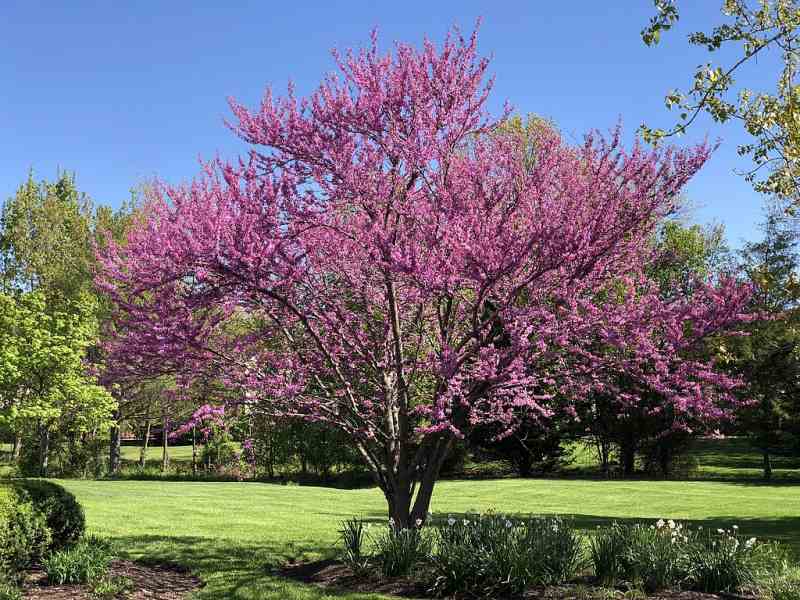
Photo Credit: Famartin / Wikimedia Commons / CC BY-SA 4.0
The eastern redbud, a stunning deciduous native tree, thrives in the Western Pennsylvania region, boasting vibrant pink flowers. The heart-shaped leaves provide a beautiful fall color, making it a great addition to any landscape. Renowned for its beauty and hardiness, the eastern redbud is an ideal choice for those seeking a low-maintenance, yet visually striking native plant in the Southwest region of the state.
Plant type: Tree
USDA Hardiness Zone: 4 to 9
Sun: Full sun or partial shade.
Soil: Any moist, well-draining, nutrient-rich soil
Duration: Deciduous perennial
Bloom time: Spring
Water needs: Keep the soil moist to a depth of 2 to 3 inches; watering schedule depends on your soil type, but you should water about once per week
Mature height: 20 to 30 feet tall with a 25 to 35 foot spread
Maintenance: Low; since this tree is not meant to transplant, it should be planted when young and left undisturbed; needs occasional pruning
3. Red Columbine (Aquilegia canadensis)
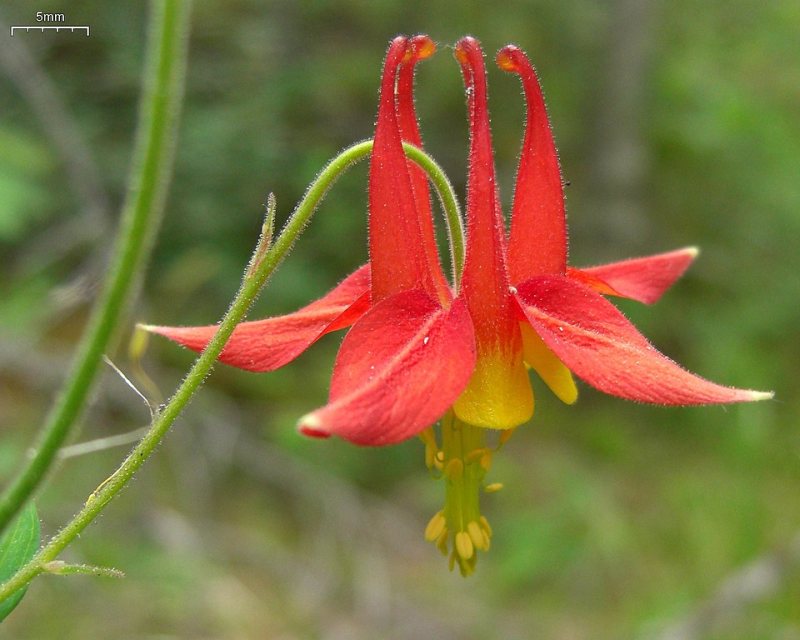
Photo Credit: Jason Hollinger / Wikimedia Commons / CC BY 2.0
Red columbine is a native woodland wildflower featuring delicate red and yellow flowers. It blooms in spring and summer, adding a splash of color to your landscape, and is highly favored by hummingbirds. This plant is an excellent low-maintenance option for gardeners seeking to create a wildlife-friendly environment.
Plant Type: Flower
USDA Hardiness Zone: 3 to 8
Sun: Full sun or partial shade
Soil: Clay, silt, or sandy soil that’s well-drained, moist, dry-ish
Duration: Perennial
Bloom Time: Spring and summer
Water Needs: Moderate; water weekly or whenever soil is completely dry
Mature Height: 1 to 3 feet
Potential Hazards: Moderately flammable
Maintenance Needs: Low; deadhead blooms as needed, cut back in late summer
4. New England Aster (Symphyotrichum novae-angliae)
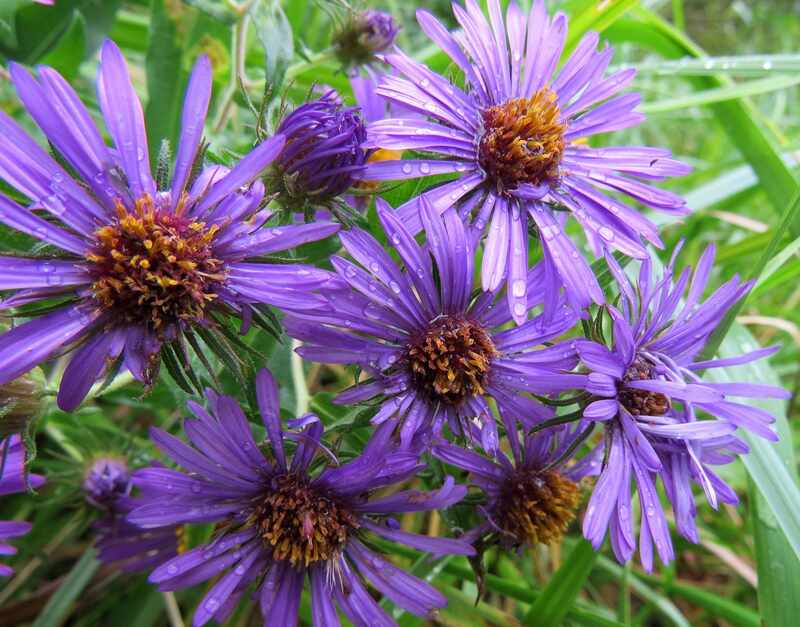
Photo Credit: USFWS Midwest Region / Flickr / Public Domain Mark 1.0
New England aster boasts vibrant purple or blue blossoms that flourish in late summer and fall, enticing butterflies and various pollinators. This stunning plant offers a crucial late-season nectar source for local wildlife, contributing to the region’s ecological balance and natural beauty. This makes New England aster a top choice for those looking to create an eco-friendly and visually stunning garden.
Plant type: Flower
Hardiness zones: 4a to 8b
Sun: Full sun to partial shade
Soil: Sandy, loamy, clay soil
Duration: Perennial
Bloom time: Late summer to fall
Water needs: Medium
Mature height: 3 to 6 feet
Maintenance: Medium; may require staking or other support if it grows tall; pinch back stems before midsummer to control the plant height and produce more flowers
5. Wreath Goldenrod (Solidago caesia)
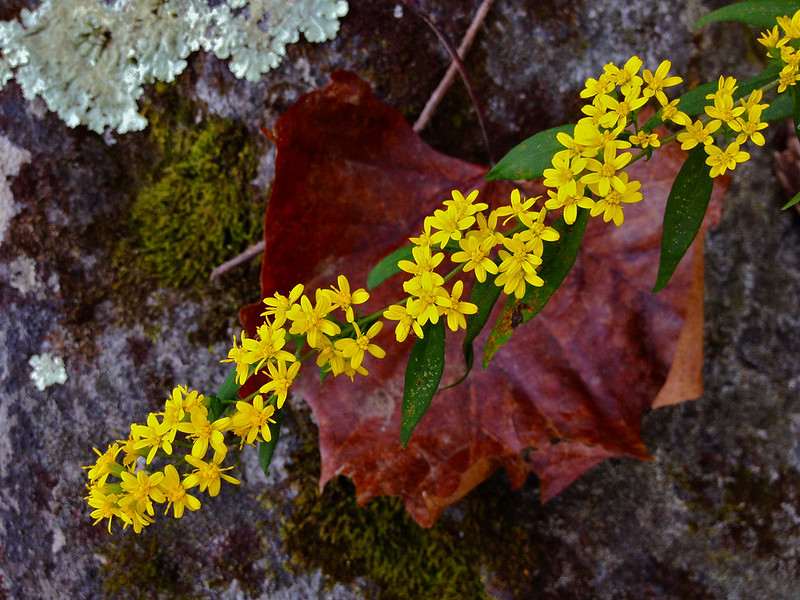
Photo Credit: Fritz Flohr Reynolds / Flickr / CC BY-SA 2.0
Wreath goldenrod, a native perennial wildflower, boasts vibrant yellow blossoms that bloom in Western Pennsylvania during late summer and fall. This plant not only adds a vivid splash of color to the landscape but also serves as a crucial food source for pollinators. Incorporating Wreath Goldenrod into your garden is an excellent way to support local ecosystems while enhancing your outdoor space.
Plant type: Perennial herb
USDA Hardiness Zone: 4 to 8
Sun: Full sun to partial shade
Soil: Well-drained acidic and neutral soils.
Duration: Perennial
Fragrance: Aniche scent
Bloom time: August to October
Water needs: Low to Medium
Mature height: 1 to 3 feet
Maintenance: Low
6. Swamp Milkweed (Asclepias incarnata)
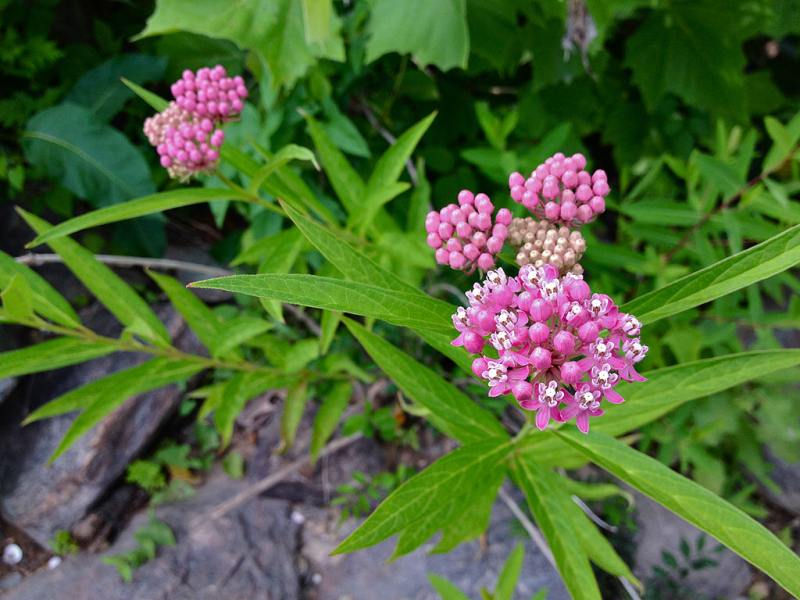
Photo Credit: Fritzflohrreynolds / Wikimedia Commons / CC BY-SA 3.0
Swamp milkweed, a native perennial wildflower, showcases vibrant pink flowers that bloom in summer and fall. This plant is crucial for Monarch butterflies, acting as a host for their larvae. Ideal for marsh or wetland gardens, swamp milkweed is an excellent addition to any Western Pennsylvania landscape.
Plant type: Flower
USDA Hardiness Zone: 3 to 8
Sun: Full sun
Soil: Mucky clay soils; neutral to acidic soil
Duration: Perennial
Fragrance: Vanilla
Bloom time: June to October
Water needs: High
Mature height: 3 to 5 feet
Potential hazards: Non-toxic; no safety hazards
Maintenance: Low
7. Butterfly Weed (Asclepias tuberosa)
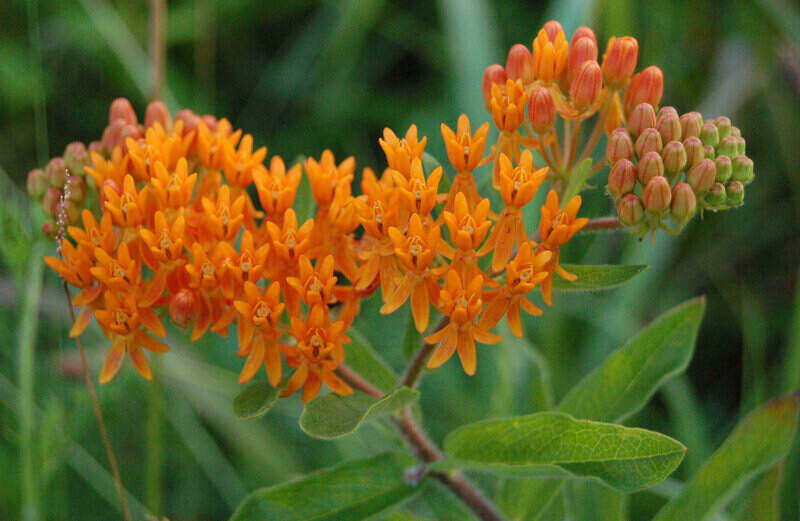
Photo Credit: Photo by Derek Ramsey (Ram-Man) / Wikimedia Commons / CC BY-SA 2.5
Butterfly weed is a native perennial wildflower with bright orange flowers that bloom in late spring to early fall. It is an important host plant for monarch butterflies and provides nectar for various pollinators. Incorporating butterfly weed into your garden not only adds color but also contributes to a healthy ecosystem in the Southwest Pennsylvania region.
Plant type: Herb
USDA Hardiness Zone: 3 to 9
Sun: Full sun
Soil: Clay, loam, sandy soil
Duration: Perennial
Fragrance: Vanilla
Bloom time: May to September
Water needs: Low
Mature height: 1 to 2 feet
Potential hazards: Toxic to people, pets, and other animals
Maintenance: Low
8. Scarlet Beebalm (Monarda didyma)
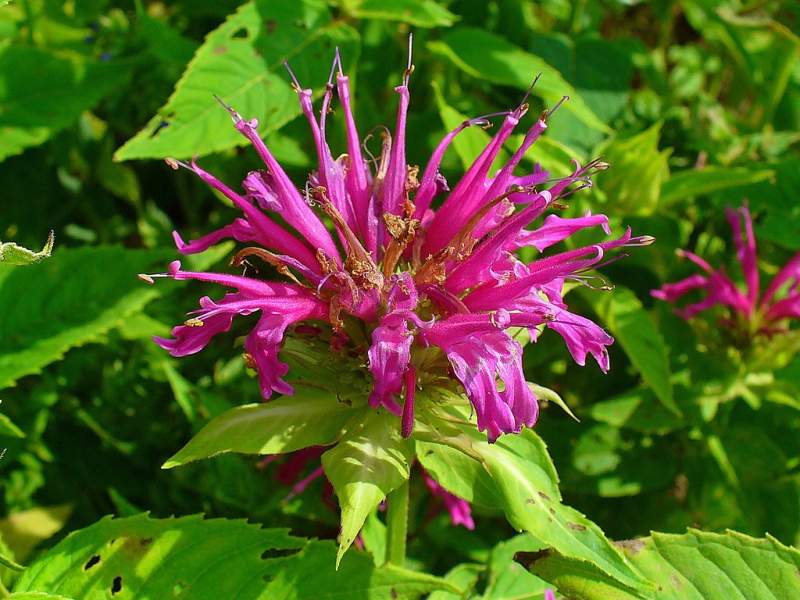
Photo Credit: H. Zell / Wikimedia Commons / CC BY-SA 3.0
Scarlet beebalm is a native perennial wildflower with showy, tubular red or pink flowers that bloom in late spring to mid-fall. This vibrant plant is a favorite among hummingbirds, bees, and butterflies, creating a lively atmosphere in any garden. Furthermore, scarlet beebalm is low-maintenance, drought-tolerant, and resistant to deer and rabbits, ensuring a thriving and beautiful garden.
Plant type: Herb
USDA Hardiness Zone: 4 to 10
Sun: Full sun to partial shade
Soil: Moist, acidic, rich soil
Duration: Perennial
Fragrance: Minty
Bloom time: May to October
Water needs: Moderate
Mature height: 2 to 4 feet tall, but can get to 6 feet
Maintenance: Low to moderate
9. Cardinal Flower (Lobelia cardinalis)
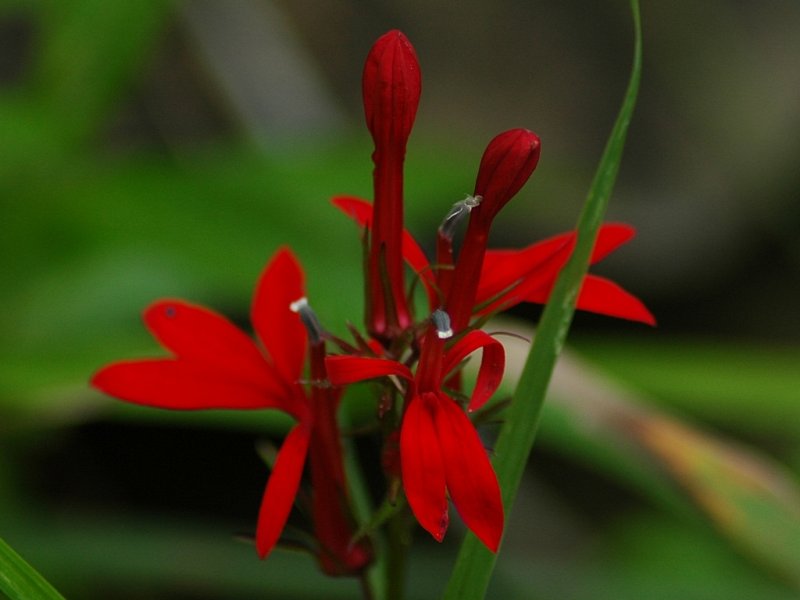
Photo Credit: linnaeus / Wikimedia Commons / CC BY 3.0
Cardinal Flower is a native perennial wildflower with striking red flowers. Renowned for its ability to attract hummingbirds, this vibrant plant adds a brilliant pop of color to any landscape.
Thriving in various soil types and shades, the cardinal flower can grow up to 6 feet tall. Its low-maintenance nature and ability to naturalize make it a popular choice for both novice and experienced gardeners in the region.
Plant type: Flower
USDA Hardiness Zone: 3 to 9
Sun: Full sun, partial shade, full shade
Soil: Sand, loam, clay, limestone-based
Duration: Perennial
Bloom time: Early fall, late summer, mid-summer
Water needs: Moderate to high
Mature height: 1 to 6 feet
Potential hazards: Toxic to humans and other animals if ingested.
Maintenance: Low
How to Choose Native Plants for Your Western Pennsylvania Landscape
Discover the ideal native plants for your western Pennsylvania garden by considering your outdoor space’s specific characteristics and conditions. Use this guide to help you choose the best native plants for your outdoor oasis:
- Track the sunlight: Observe your garden at various times throughout the day and note which sections receive full sun, partial shade, or complete shade. Keep in mind that native plants flourish when situated in conditions that closely resemble their natural habitats.
- Understand your soil: Analyze your soil to determine its composition. With this information, you’ll be able to select native plants that will prosper in your garden’s specific soil type.
- Assess drainage and moisture levels: Examine your garden’s drainage system and the moisture content in your soil. This knowledge will help you find plants that can comfortably grow in your garden’s unique setting.
Moreover, it’s best to look for plants that are well-suited to your region’s USDA hardiness zone, which for Western Pennsylvania ranges from 5 to 7. By selecting plants that thrive in your area, you’ll have a healthier and more sustainable garden.
FAQ About Western Pennsylvania Native Plants
What plants are native to Pittsburgh?
Plants native to Pittsburgh include:
- Eastern Redbud
- Black-Eyed Susan
- Virginia Bluebells
- Wild Geranium
- Wild Columbine
- New England Aster
- Butterfly Weed
- American Holly
- Marsh Blazing Star
- Aromatic Aster
- Black Birch
What native plants are ideal for the wetlands in Allegheny County?
The wetlands in Allegheny County provide a unique habitat for various native plants. Some popular choices include swamp milkweed (Asclepias incarnata) and cardinal flower (Lobelia cardinalis). These plants are well-suited for wetland environments and will add beauty and functionality to your local landscape.
What native trees are best for Pittsburgh’s urban environment?
When selecting a native tree for Pittsburgh’s urban environment, it’s crucial to choose a native plant species that can tolerate pollution, limited space, and varying soil conditions. Eastern redbud (Cercis canadensis) is a good choice because it is hardy, attractive, and beneficial for the local ecosystem.
What are some native plants that attract pollinators in Washington County?
Encouraging pollinators to visit your garden is essential for maintaining a healthy ecosystem. In Washington County, consider planting native species such as wreath goldenrod (Solidago caesia) and butterfly weed (Asclepias tuberosa). These plants will provide nectar and pollen for bees, butterflies, hummingbirds, and other pollinators, supporting biodiversity in the area.
Where to Find Native Plants in Western Pennsylvania
Transform your western Pennsylvania garden into a breathtaking oasis using native plants. To get started on your botanical quest, consider visiting well-regarded native plant nurseries in Western Pennsylvania, as recommended by the Pennsylvania Native Plant Society.
Planting native plant species is only one of many low-maintenance landscaping ideas for people living in Western Pennsylvania. To further enhance your outdoor haven, research the best grass seeds for your specific county to complement your native plant selections.
Don’t forget to invest in proper yard care to preserve your landscape’s health and beauty. Connect with a lawn care pro near you who can handle the yard’s mowing, trimming, and edging needs. We have trusted pros in Pittsburgh and many other cities throughout Western Pennsylvania.
Main Photo Credit: Phipps Conservatory, Pittsburgh / GPA Photo Archive / Flickr / CC BY 2.0